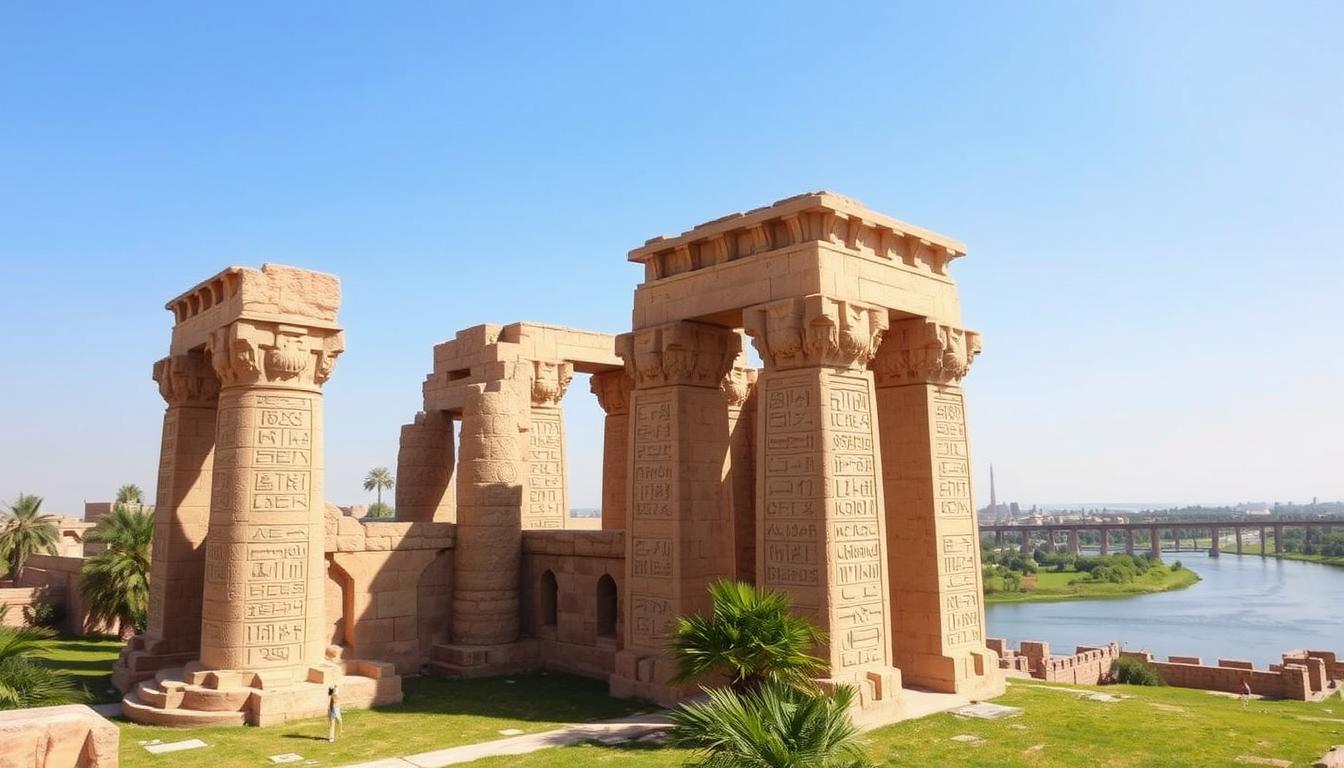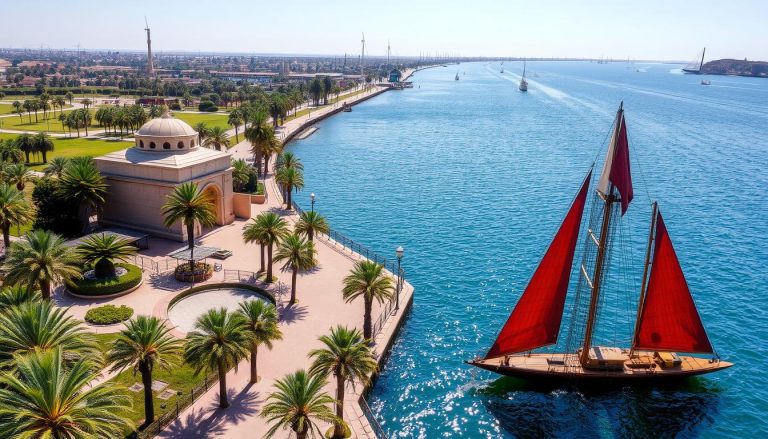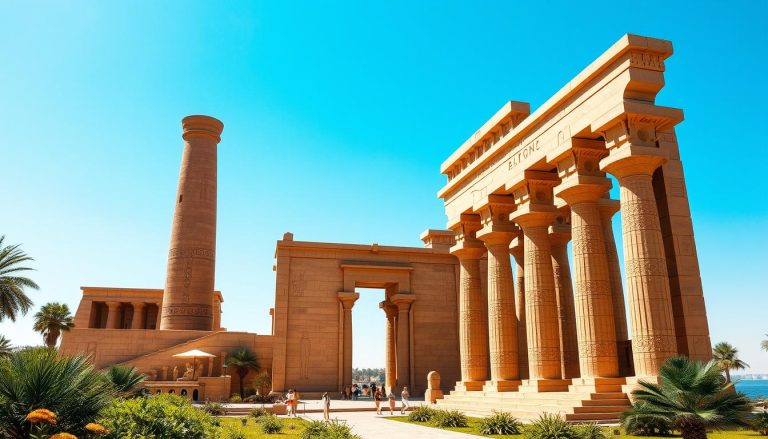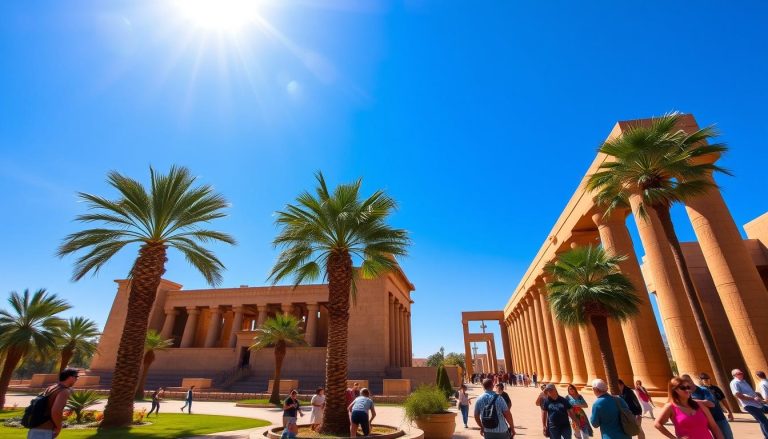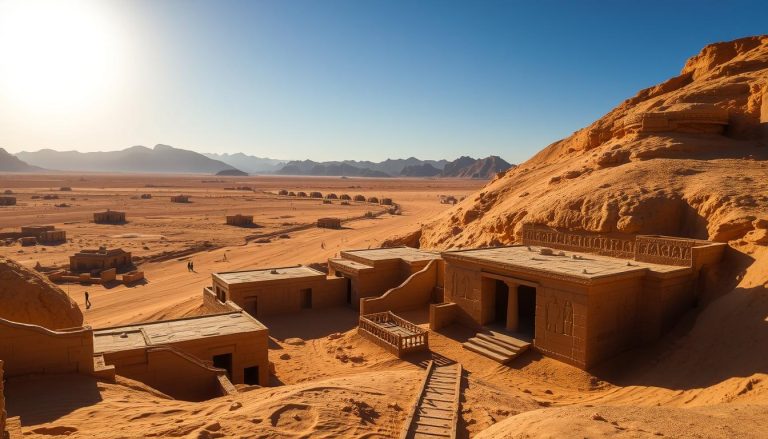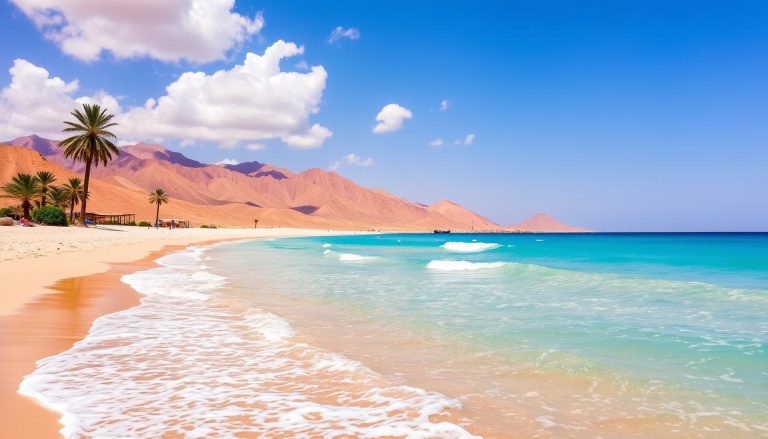Ever dreamed of exploring ancient Egyptian ruins? Discovering secrets of a double temple dedicated to two powerful gods? Welcome to Kom Ombo, a remarkable site along the Nile River in Aswan Governorate, Egypt. This temple complex gives a peek into the rich history and religious traditions of the Pharaonic era.
What’s special about Kom Ombo? Its stunning Nile River views and unique temple architecture stand out. The temple has symmetrical halves for Sobek, the crocodile god, and Horus, the falcon god. Walking through, you’ll see well-preserved hieroglyphics and reliefs that tell stories of ancient Egyptian myths and rituals.
Key Takeaways
- Kom Ombo is a unique double temple dedicated to the gods Sobek and Horus
- The temple’s architecture is symmetrical, with two identical halves and separate entrances
- Visitors can explore the temple’s impressive hieroglyphic carvings and ancient artwork
- Kom Ombo offers stunning views of the Nile River and insight into ancient Egyptian religious practices
- The site is a must-visit for travelers interested in archaeology and ancient history
Introduction to Kom Ombo's Historical Significance
The Kom Ombo Temple in Egypt sits on the Nile River’s banks. It has a history that goes back to the Ptolemaic era (180-47 BC). This temple is a masterpiece from the Ptolemaic dynasty, showing the dual deity temples of ancient Egyptian history.
The temple is special because it honors both the crocodile god Sobek and the falcon god Horus. This design highlights the Ptolemaic period’s diverse beliefs and architectural skills. Kom Ombo was also a key spot for trade, worship, and cultural exchange back then.
When you visit Kom Ombo, you can dive into its ancient stories. You’ll see detailed hieroglyphics, sacred items, and well-kept buildings. These tell the tale of this important time in Ptolemaic architecture and ancient Egyptian history.
If you love history, architecture, or just Egypt’s rich culture, Kom Ombo will amaze you. It’s a place that leaves a deep mark and broadens your view of Egypt’s past.
Exploring the Unique Double Temple Architecture
Kom Ombo’s double temple is a rare marvel in ancient Egypt. It shows the skill of ancient builders. The temple honors Sobek, the crocodile god, and Horus, the falcon god, equally. This reflects the Egyptians’ complex religious beliefs.
The Temple of Sobek
The left side of the temple is for Sobek, the crocodile god. He’s linked to fertility, the Nile, and military power. This section has its own entrance, hypostyle hall, and inner sanctuary.
Archaeologists found over 300 mummified crocodiles here. The Sobek Temple’s calendar lists the offerings and celebrations for Sobek throughout the year.
The Temple of Horus
The right side is for Horus, the falcon-headed god. He’s associated with the sky, kingship, and protection. Like Sobek’s side, it has its own entrance, hypostyle hall, and sanctuary.
Horus was a key deity in ancient Egyptian mythology. He was seen as a protector of pharaohs.
Architectural Features and Design
The Kom Ombo Temple’s design is a mix of ancient Egyptian and Greek styles. It has towering columns, intricate reliefs, and a nilometer. These features show the temple’s grandeur.
The symmetry and detail in the temple’s design are impressive. They highlight the advanced engineering and artistic skills of the ancient Egyptians.

“The temple’s dual deity design is a rare and remarkable example of ancient Egyptian architectural ingenuity.”
Best Time to Visit and Practical Tips
Planning your Egypt travel? The best time to visit Kom Ombo is from October to April. During this time, the weather is mild and pleasant. For the best photos, visit early morning or late afternoon.
Kom Ombo is a key stop on many Nile River cruises. This makes it easy to explore this amazing site.
When you visit, don’t forget sun protection, comfy shoes, and lots of water. The temple is open from 7 AM to 5 PM every day. Entrance fees are about 140 Egyptian Pounds for adults.
Remember, the Egyptian Pound is the official currency. It’s best to carry cash, as credit cards might not work everywhere, especially at budget places.
| Tip | Details |
|---|---|
| Currency | Egyptian Pound (LE), with common banknote denominations of 5, 10, 20, 50, 100, and 200LE. Credit cards are increasingly accepted but mainly in higher-end establishments. |
| SIM Cards | A SIM card in Egypt costs around 134 LE ($22 CAD) and includes 6GB of data. Global wifi hotspots like Skyroam are also available. |
| Drinking Water | Bottled water is recommended as tap water is unsafe to drink in Egypt. |
| Travel Insurance | Travel insurance is essential, with WorldNomads and Allianz being recommended options. |
Whether you’re visiting for a short time or a long Egypt travel tips trip, Kom Ombo is a must-see. It gives you a peek into the ancient wonders of the Nile River cruises and the Aswan attractions of Egypt.
Ancient Egyptian Religious Practices at Kom Ombo
The Kom Ombo Temple in Aswan offers a peek into ancient Egyptian religion. This famous temple was dedicated to Sobek, the crocodile god, and Horus, the falcon-headed god. It shows the beliefs and rituals of the ancient Egyptians who lived there.
Sacred Crocodile Worship
Kom Ombo is known for its Sobek worship. Crocodiles were seen as sacred animals. The temple had a sacred crocodile pool where people showed devotion.
Mummified crocodiles are displayed, connecting us to ancient rituals. These rituals honored Sobek, the powerful crocodile god.
Medical and Healing Traditions
Kom Ombo was also a center for ancient Egyptian medicine. The temple’s walls show carvings of medical tools and procedures. It was a place for treating illnesses and keeping people healthy.
This shows how ancient Egyptians combined religion and medicine. They believed in a holistic approach to health.
Religious Ceremonies and Rituals
The Kom Ombo Temple’s design gives clues about ancient ceremonies. Its dual structure, for Sobek and Horus, shows complex beliefs. Visitors can picture the grand processions and priestly incantations.
Exploring the temple, we learn about ancient Egyptian beliefs. We see how Egyptian religion, Sobek worship, and Horus worship intertwined.
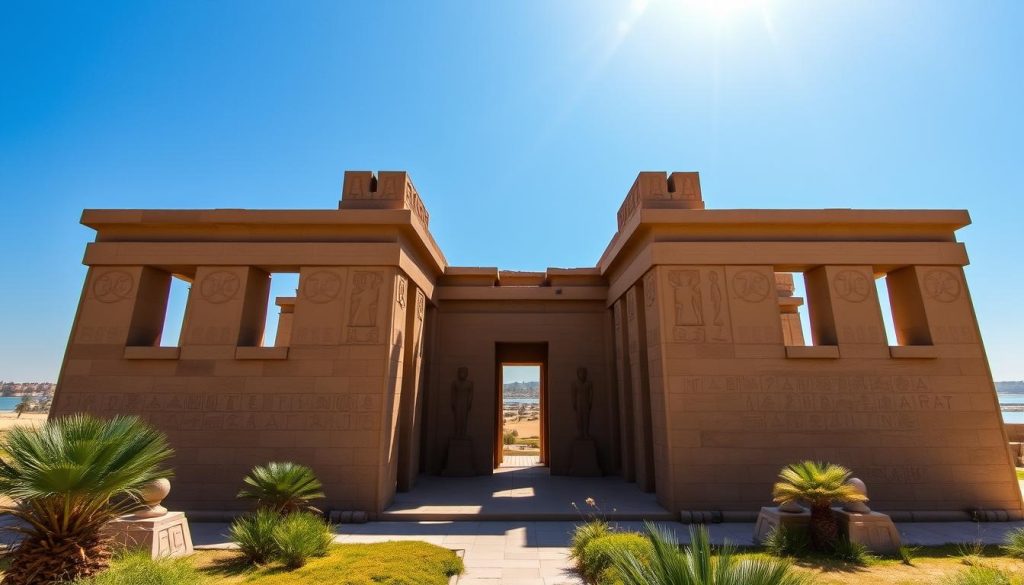
Hieroglyphics and Ancient Artwork
The Kom Ombo Temple is home to ancient Egyptian art. It includes detailed hieroglyphic inscriptions and temple reliefs. These carvings and writings give us a peek into the culture and history of this ancient civilization.
The temple walls show off beautiful reliefs. They depict Egyptian deities, pharaohs, and scenes of everyday life. One carving even shows the first known ancient medical tools. Another relief shows an ancient Egyptian calendar. These inscriptions and reliefs offer deep insights into the ancient Egyptians’ beliefs and advancements.
Visiting the hieroglyphics and artwork at Kom Ombo is an immersive experience. It lets visitors connect with the rich heritage of this civilization. The detailed carvings and writings take you back in time. They help us appreciate the ingenuity and artistry of ancient Egyptian culture.
The Nilometer and Ancient Engineering
Kom Ombo’s nilometer shows the ancient Egyptians’ smart water management. This structure measured the Nile River’s water levels. It helped predict floods and figure out taxes.
Understanding Water Level Measurements
The nilometer has a staircase down to the river. The walls have marks for water levels. This way, the ancient Egyptians could plan for floods and farming.
Historical Significance of the Nilometer
The nilometer at Kom Ombo shows the ancient Egyptians’ engineering skills. It was not just useful but also sacred. The Nile’s rise was seen as a gift from gods.
The nilometer’s detailed measurements and design show the ancient Egyptian engineering skill. It helped the civilization thrive along the Nile River history and manage water well.
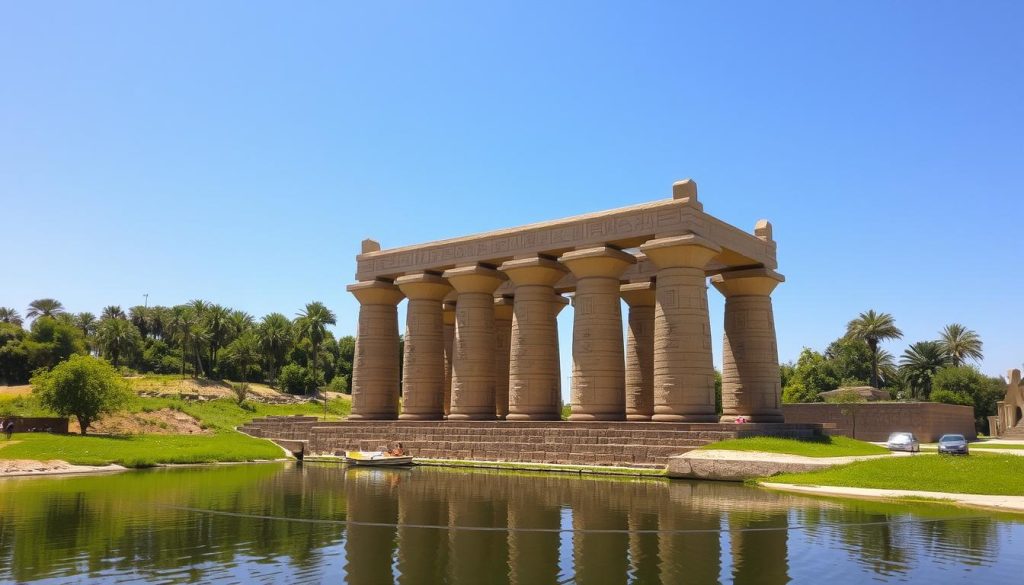
“The nilometer at Kom Ombo is a remarkable example of how the ancient Egyptians harnessed their understanding of hydrology to serve the needs of their society.”
Kom Ombo, Egypt: Best Things to Do - Top Picks
Kom Ombo sits on the Nile River’s banks, offering many exciting experiences. The Kom Ombo Temple complex is a must-see. It’s a unique double temple dedicated to Sobek and Horus. You’ll see amazing hieroglyphics and mummified crocodiles, giving a peek into ancient Egypt.
Don’t miss the temple’s evening sound and light show. As the sun sets, the temple lights up with music and narration. It feels like stepping back in time.
Kom Ombo has more to offer than just the temple. Take a peaceful felucca ride on the Nile. You’ll see beautiful views and watch the sunset. Or, explore the local market to dive into the culture, see crafts, and smell spices.
It’s also a great spot to see nearby sights like the Aswan High Dam and Nubian villages. Kom Ombo’s history, architecture, and Nile views make it a key stop for anyone wanting to see Egypt’s beauty.
| Top Kom Ombo Attractions | Entrance Fees |
|---|---|
| Kom Ombo Temple | 450 EGP per adult, 230 EGP per student |
| Crocodile Museum | Included with Kom Ombo Temple ticket |
| Nile River Felucca Ride | Around $70 USD for a one-hour trip |
| Aswan High Dam | 200 EGP per adult, 100 EGP per student |
| Nubian Museum | 300 EGP per adult, 150 EGP per student |
Kom Ombo is very sunny, with almost 4,000 hours of sun a year. So, remember to bring sunscreen and stay hydrated. Enjoy your time exploring this amazing Nile River spot!
Nearby Attractions and Day Trips
Kom Ombo is a great spot for seeing other amazing places in Aswan. You can visit the Aswan High Dam or explore Nubian villages along the Nile. There’s lots to see and do nearby.
Aswan High Dam
The Aswan High Dam is close to Kom Ombo. It’s a huge dam built in the 1960s. It helps control the Nile River and gives power and water to the area. Visitors can see its size and learn about its importance.
Nubian Villages
Take a boat to the Nubian villages. There, you can dive into the rich culture of this special community. You can visit markets, try Nubian food, and talk to the locals. These villages show a life shaped by the Nile River.
Edfu Temple
Don’t miss the Edfu Temple, near Kom Ombo. It’s a beautiful temple for the god Horus. Many people see it on a Nile River cruise. It’s a great way to see the river and ancient Aswan attractions.
| Nearby Attraction | Distance from Kom Ombo | Description |
|---|---|---|
| Aswan High Dam | 45 km | A modern engineering marvel that controls the flow of the Nile River and provides electricity and irrigation for the region. |
| Nubian Villages | 30 km | Charming riverside communities that offer a glimpse into the rich cultural heritage of the Nubian people. |
| Edfu Temple | 60 km | A well-preserved ancient Egyptian temple dedicated to the falcon-headed god Horus, often included in Nile River cruise itineraries. |
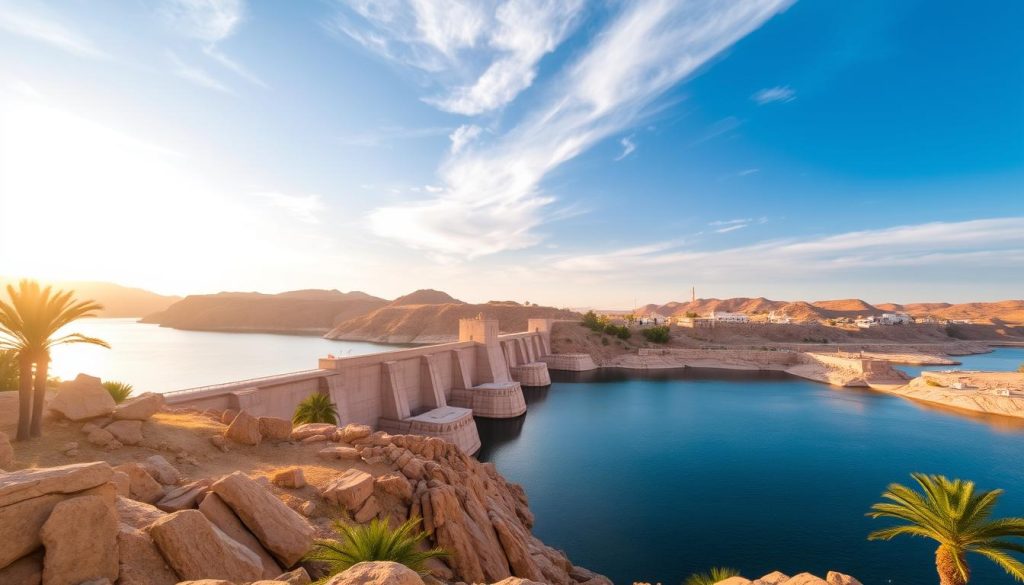
“Exploring the nearby attractions around Kom Ombo provides a well-rounded experience of the region’s history, culture, and natural wonders.”
Photography Opportunities and Viewpoints
Kom Ombo, by the Nile River, is a paradise for photographers. It offers stunning views for both pros and hobbyists. The temple’s riverside setting is perfect for capturing the beauty of Egypt photography and temple photography.
The golden hours, early morning or late afternoon, are the best times to shoot. The soft sunlight brings out the temple’s colors and textures. It casts beautiful shadows on its reliefs and architecture. Key spots include the hypostyle hall, the historic nilometer, and the temple’s outer walls with Nile River views.
- Capture the temple’s reflection in the tranquil waters of the Nile River
- Explore the hypostyle hall’s forest of columns and play with light and shadow
- Immortalize the nilometer, a testament to ancient Egyptian engineering
- Freeze-frame the temple’s ornate outer walls and their captivating hieroglyphic carvings
Kom Ombo is perfect for photographers of all levels. It offers endless chances to take amazing photos. These photos will take you back in time and fill you with wonder. Let Kom Ombo’s timeless beauty inspire your Egypt photography, temple photography, and Nile River views.
Local Culture and Modern Life
The town of Kom Ombo, by the Nile River, shows the rich mix of Egyptian and Nubian cultures. It’s full of life, from busy markets to cultural experiences. Here, you can see how traditions are part of everyday life.
Traditional Markets
Walking through Kom Ombo’s local markets is a treat for your senses. You’ll see Egyptian handicrafts, like Nubian textiles and spices. It’s fun to haggle with vendors, feeling the market’s lively energy.
Cultural Experiences
Kom Ombo has lots to offer beyond the markets. Enjoy music and dance performances that bring ancient sounds to life. Try authentic Egyptian cuisine and Nubian bread. You can even learn henna painting, a tradition passed down through generations.
Visiting Nubian villages lets you dive deeper into local traditions. Meet the friendly people, learn about their customs, and see the colorful buildings that show their heritage.
Kom Ombo is a place that pulls you into the heart of Egyptian culture. It’s a journey filled with authentic experiences, from markets to cultural events. This town promises a memorable and real adventure.
Transportation and Accessibility
Kom Ombo is about 50 km north of Aswan. It’s a popular stop for those on Egypt travel adventures, like Nile River cruises. Taxis and private transfers from Aswan make it easy to get there.
The Kom Ombo temple is wheelchair friendly, with ramps for everyone. Local guides at the entrance offer deep insights into the site’s history and culture. Whether you’re on a tour or solo, Aswan transportation makes visiting easy.
When planning a trip to Kom Ombo, think about your travel and accessibility needs. With some planning, you can fully enjoy this amazing temple complex as part of your Egyptian journey.
